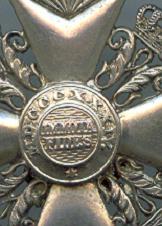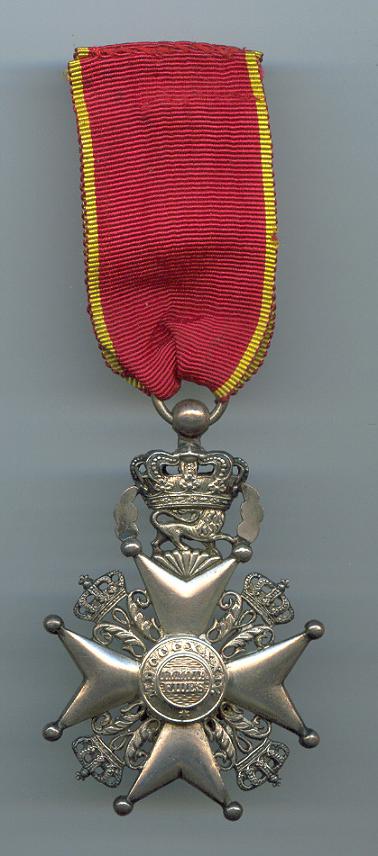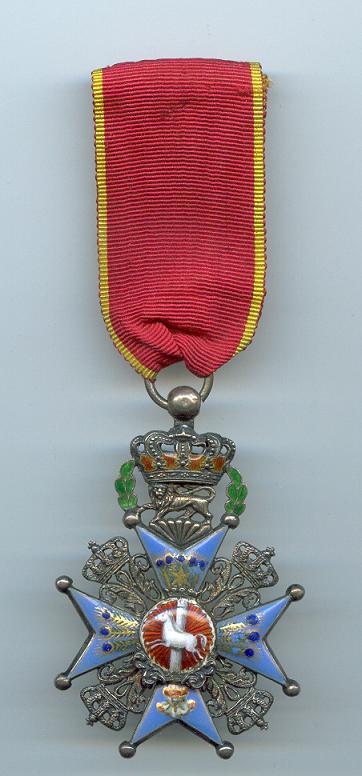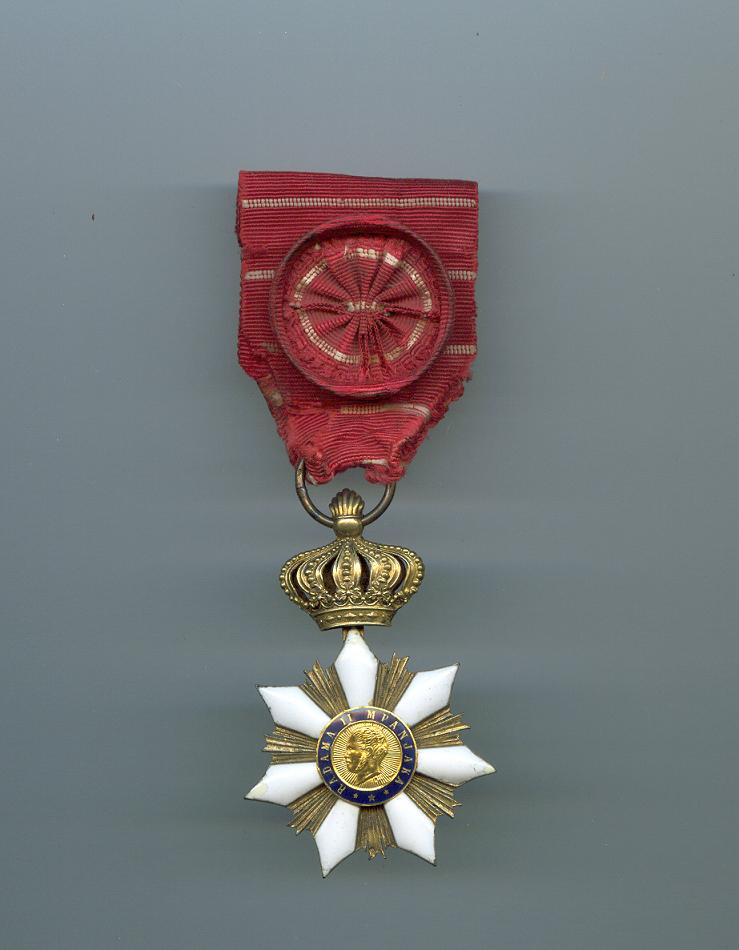-
Posts
809 -
Joined
-
Last visited
Content Type
Profiles
Forums
Blogs
Gallery
Events
Store
Posts posted by Yankee
-
-
the ribbon for the cross of mercy is bleu-ish
but this ribbon is green.
Concerning the ribbon of the order of st Anna, there was also a medal of Zeal, which had been awarded quite extensive! The ribbon denoted the rank of the receipment, soldiers would receive this medal on the ribbon of a lower order than NCO's.
A medal of zeal is quite possible...
Kind regards,
Jacky
Hi Jacky
That is a very likely possibility since the St. Anne ribbon was widely used on other medals. I apologize for not being clear it was the medal ( badge of honour ) to the St. Anne order that I was thinking on. Thanks for that
Sincerely
Yankee
0 -
Ooops my mistake, he disposed of his St.Anne but decided to keep his Serbian decoration that is odd
Sincerely
Yankee
0 -
Nice bar, certainly is the correct ribbon for the St. Anne order or the medal which I strongly doubt. Prior to WWl this combination could very well be.
0 -
Hi Yankee,
Yes, they really got themselves in a fix by putting those swords under the cross, didn?t they? Sort of ?It seemed like a good idea at the time? thing. I think that the best answer would have been to have run them through the center, as they ultimately did; and then for emphasis a different ribbon could be attached - along the line of the Prussian (Red Eagle and Crown) orders with swords being put on the Iron Cross ribbon.
Granted that due to the ornate nature of this insignia, the swords tended to blend in. Has anyone noticed that where the swords are against silver ?W?s? (knight 2nd class), as you mention, they are gold; but in all other grades where they are against gold ??W?s?, they are silver. In the cases of the 4th class, officer?s cross and 1st class cross, where there are no ?W?s?, they are in gold - with one rare and little known exception. When an officer?s cross was awarded to a recipient who had swords on the knight first class, the swords on the officer?s cross would be silver.
This brings up your suggestion about following ?...the other German States & run the swords above the crown?. Actually, in the case of the knight 1st, commander and grand cross classes, when the recipient held the swords in the lower grade(s), the insignia would have the swords ?on ring?, as you suggest.
Lastly, no, on the contrary, surprisingly few were awarded in World War I. According to Reckewell/Fischer, between 1908 and 1918, five knights 1st class and two knights 2nd class with swords were awarded. As an aside, only one 4th class with swords was ever awarded - by some standards a relative low award, but they don?t get any rarer.
I hope that you find some of this information interesting and useful.
Best wishes,
Wild Card
Hi Wild Card
Thanks a bunch for all that helpful info, certainly a lot to digest. I had always been curious why some badges would have swords on ring and others of the same class on bottom so as I understand now when he was promoted to a higher class of the order as a mark of distinction his swords would also be elevated. I assume these same rules would apply to the Prussian order system which I find extremely complex. In some examples I see ( Prussian ) swords awarded twice on the same badge, through the center & on ring. Since the swords were awarded so sparingly ( Brunswick ) in WWl was it given out as a military order to soldiers without swords & only for the most heroic acts of courage the swords were added? Or was Henry The Lion basically a civil order that is why not so many swords awarded? Fascinating that the swords were planned to be of a different metal from the rest of the badge and as you say blends in. Which it does beautifully, certainly one of the most striking orders ever designed, the heraldry just flows all over. Thank you
Sincerely
Yankee
0 -
Hi Wild Card
I see clearly what you are saying in how easily the swords can be damaged by having the swords below the cross. I'm surprised Brunswick did not follow the other German States & run the swords above the crown. Your point is excellent to show the swords as military and for all to see, then it would be advantageous on the bottom. What is interesting it took nearly 40 years to make the change, wonder why so long? I suppose a great amount of swords were given out in WWl... I saw one with gold swords that beonged to a knight 2nd class that ran through the center, an order with many combinations. Thank you for showing me your knight the way it should be

Sincerely
Yankee
0 -
-
Andreas has written about this order on his site!
It's very complete and nicely written!
Kind regards,
Jacky
p.s. nice pictures of your order!
This one differs from andrea's pictures...
This is a knight 2nd class.
But the non enamelled reverse is something which I can't explain....
Could this be possible that this is a private purchase??
Hi Jacky
Ow yeaaa Andreas's site is fantastic
 Never thought of private purchase that would explain seldom seen, thanks for that.
Never thought of private purchase that would explain seldom seen, thanks for that.Sincerely
Yankee
0 -
 WOW!!!
WOW!!!  That's a BEAUTIFUL medal!!! Would you Please tell me more about it?
That's a BEAUTIFUL medal!!! Would you Please tell me more about it? Doc
DocHi Doc
Wish I knew more but I'm at a dead end. Hoping there is a Brunswick specialist out there who has come across these. Maybe a trial model, prototype that just never took off.
Sincerely
Yankee
0 -
-
-
Dear Members
Would any collector have any ideas why the reverse to a Henry knight's order be without enamel. The badge itself seems to be nicely made of old quality. Perhaps intended for a medal bar or economy piece. Any help would be greatly appreciated. Thanks
0 -
Hi Ricardo
That would make sence, since one sees mostly knights since they were more awarded. Now I wonder if the same rule applies for the Southern Cross. Take a look at Morton&Eden part 3, there is a nice selection of Brazilain material
 .
.Sincerely
Yankee
0 -
Hi, Yankee
I have no info on the medal itself, but I'm able to shed some light on the events that inspired it.
The plague was in 1857, in Lisbon, caused by Yellow Fever. It is said to have killed 10% of the city's population. Many hospitals were raised, so I believe the medal was targeted at the people that worked there.
History says that Lisbon stopped, people were afraid to leave their houses, streets were empty, shows were closed. Funeral processions were carried out only with priest and digger - well, plague environment all round...
To show its importance, even King D. Pedro V visited somes hospitals, suposedly against the advice of his aides. This would also explain why a medal was issued, as the new liberal kings were very keen to public health.
Also, I found a photograph of King D. Pedro V with the medal, just right of the Order of The Tower and the Sword. Obviously, his Majesty was very proud of it:
Hi Jorge
Thanks for the info, every bit helps for there is very little info on this uncommon medal. I was surprised to see King Pedro V to see wearing the medal as you say must have had an active participation in the crisis. I think they were also awarded in gold but that was probably reserved to the King and a few select others. Perhaps awarded in the same conditions as the Hong Kong Plague Medal. There might already be an article out in the Instituto Georgrafico Portugues Museu on the subject, hoping the author will remember to send me out a copy.
Sincerely
Yankee
0 -
Hello Gentlemen
Over the past few years every now and then I'd see a Rose come up for sale & for the life of me could never distinguish the difference between a Oficial ( Officer ) & Cavaleiro ( Knight ). Always had crown & a good many were issued in both classes. Can any member please shed some light.
 Thanks0
Thanks0 -
A French language, paper bound book, entitled something like "Decorations Malagache", published in the late 1960s - early 70s? describes Malagasy decorations up to that time. It includes some information on royal award criteria. The book has a number of illustrations most of which are poor quality. I believe FJP auctioned a copy in the past few years and it's sometimes available from French sources.
Like the book's authors (the Chavincourts? who lived in Madagascar), Colonel Guyadier opined that most Radama II awardees were either French government (civil & military) officials or those closely related to the convoluted Malagasy elite. Overall numbers under Radama II were fairly limited and there is some discussion on this topic in 1960s-70s Sabretache articles. Queen Ranavalona III was supposedly more generous with her decorations. It is unclear whether additional decoration examples were manufactured in the 1890s or again in the 1920s. (Perhaps for collectors?) Most insignia is silver gilt but gold examples, including some set with precious stones, exist. Almost all insignia have French hallmarks and stars often have French jeweller ID plates on the reverse.
Google search reveals a number of illustrations of people wearing the royal Madagascar Order of Merit, including Queen Rasoherina (1863-68) who succeeded Radama II, her assassinated husband
The Malagasy national museum has only a few insignia on display, about the number you see at the Legion of Honor museum in Paris. A few Brits or Portugese may also have receive royal recognition. Several items are displayed, but not for sale at any price, in a Sandton (Jo'berg) coin shop.
Dear 922F
Thanks for all that amazing info history
 , sounds like Queen Ranavalona was as generous in awarding as Ferdinand of Bulgaria but not as nice. The badge is silver gilt with gold centers. I did notice a hallmark on the ring so perhaps the jeweler can be identified.
, sounds like Queen Ranavalona was as generous in awarding as Ferdinand of Bulgaria but not as nice. The badge is silver gilt with gold centers. I did notice a hallmark on the ring so perhaps the jeweler can be identified.Sincerely
Yankee
0 -
-
-
Hello to all
Here are pictures of the Order of Merit, established in 1861 by King Ramada ll, it seems based on the French order system ( 2nd Empire Period ) with rosette, crown & center bust of the King. In 1863 King Ramada ll was assassinated and the order became abolished . Does anybody know if the order was primarily given for civil acts or military. Was it mostly awarded to the local populace or Europeans who were stationed in the Kingdom? Excuse delay for pictures
0 -
Not really limited to W?rttemberg.
Prinz Leopold von Bayern, King Ludwig III's brother, was a Generalfeldmarschall and commander of the 9. Armee, Heeresgruppe Prinz Leopold von Bayern, Heeresfront Prinz Leopold von Bayern and was then Oberbefehlshaber Ost.
Kronprinz Rupprecht von Bayern led the 6. Armee and then Heeresgruppe Kronprinz Rupprecht von Bayern. His oldest son Erbprinz Luitpold was only 13 and died shortly after the war began. A number of other Bavarian nobles served in various capacities. Prinz Heinrich von Bayern, son of King Ludwig III's late brother Arnulf, was killed in action in Romania in 1916.
Kronprinz Wilhelm von Preu?en led the 5. Armee and then Heeresgruppe Deutscher Kronprinz. Other Prussian princes held various commands.
Friedrich August Georg Kronprinz von Sachsen, born in 1893, was too young and only an Oberleutnant in 1914. He was eventually commander of the 245. Infanterie-Brigade, though. He became a Jesuit after the war. Maybe not a 180, but close. His younger brothers were junior officers in Saxon infantry regiments.
Prinz Johann Georg, Herzog zu Sachsen, brother of King Friedrich August III, was nominally a soldier, but more of an explorer at heart, and does not appear to have taken an active military role in the war. He was only in his mid to late 40s, so age wasn't an issue.
Herzog Ernst II von Sachsen-Altenburg commanded the 8. Infanterie-Division in 1915 and 1916. The Grand Dukes of Saxe-Weimar-Eisenach, Hesse and Mecklenburg-Schwerin, the Dukes of Saxe-Meiningen and Saxe-Coburg-Gotha and the Prince of Reuss served on corps and division staffs. F?rst G?nther of the two Schwarzburgs was in his 60s and didn't hold an active command.
Others served in various capacities, and others did not.
Thanks once again for the amazing insight on the Dukes & Princes on their military service, some have lead fascinating lives. Prince Johann Georg of Saxony would be a great read. It seems not the exception but the norm that manny a fine soldier went over to the service of God. After four years of the most horrific fighting one would persue a life dedicated for peace & spirituality.
0 -
Generally, they weren't reciprocal. Schaumburg-Lippe didn't have a regiment. Its contribution to the Army was a J?ger-Bataillon and its Reserve-J?ger-Bataillonen. Other than princes of Schaumburg-Lippe, no members of ruling houses served in the B?ckeburg J?gers.
King Wilhelm II of W?rttemberg had no sons. His daughter's husband had staff jobs. King Wilhelm II had chosen as his successor Duke Albrecht of W?rttemberg, his cousin several times removed. Duke Wilhelm of Urach might have had a superior claim, but wasn't the king's choice.
Duke Albrecht started the war as a Generaloberst and commander of the 6th Army. He became a Field Marshal and commander of Army Group Duke Albrecht (Heeresgruppe Herzog Albrecht). His three sons all started out in W?rttemberg regiments - Duke Philipp Albrecht in the 2nd W?rttemberg Dragoons (DR 26), Duke Albrecht Eugen in Grenadier-Regiment K?nigin Olga (GR 119), and Duke Carl Alexander in Infanterie-Regiment Alt-W?rttemberg (IR 121). Philipp Albrecht and Carl Alexander ended up on their father's staff and Albrecht Eugen on the staff of the 14th Army. Carl Alexander later became a Benedictine monk.
Duke Albrecht's younger brother Duke Robert commanded W?rttemberg's 26. Kavallerie-Brigade in 1914 and also ended up on Duke Albrecht's staff. Duke Albrecht's youngest brother Duke Ulrich commanded the 2nd W?rttemberg Uhlans (Ulanen-Regiment K?nig Wilhelm I Nr. 20) in 1914 and later commanded the 16. Kavallerie-Brigade.
Duke Wilhelm of Urach commanded the 26. (2. Kgl. W?rtt.) Infanterie-Division in 1914 and then Korps Urach. His last command was Generalkommando z.b.V. 64 (Erwin Rommel ended up on his staff in early 1918). Passed over for the W?rttemberg throne, he did get one, though, being made King Mindaugas II of Lithuania in July 1918. Unfortunately for him, that only lasted until November 1918 (fortunately for his children, though, since that meant they weren't there when the Soviets occupied Lithuania in 1940).
Duke Wilhelm had two sons of military age. F?rst Wilhelm von Urach served with a W?rttemberg field artillery regiment, Feld-Artillerie Regiment K?nig Karl (1. W?rttembergisches) Nr. 13. F?rst Carl Gero von Urach served with GR 119. Duke Wilhelm's younger brother F?rst Carl von Urach was a retired Colonel ? la suite to the 1st W?rttemberg Uhlans (Ulanen-Regiment K?nig Karl Nr. 19).
I'm amazed to learn how so active the Royalty was in serving the Wurttemberg militaty. So many Duke's in leadership roles. I suppose it was the same in all the German States. I wonder if they had to go through the same vigorous training as other officers, was advancement easier since they were related to the King. I take it in Germany or any Kingdom at the time, the choice profession for the aristocracy was the military. Amazing how Dule Carl Alexander did a 180 degree turn in his life & opted to serve in a Monastery.
0 -
The "three smallest of the German States" were Mecklenburg-Strelitz (103,451), Waldeck (59,135) and Schaumburg-Lippe (44,992). Reu?-Greiz, Schwarzburg-Rudolstadt and Schwarzburg-Sondershausen were each smaller than Mecklenburg-Strelitz, but Reu?-Greiz is combined with Reu?-Gera and the two Schwarzburgs with each other, making them bigger.
As for "smallest...in amount of awards given", that is hard to say. Award numbers don't compare well for a number of reasons. Both Mecklenburg-Strelitz and Schaumburg-Lippe had single awards, the Cross for Distinction in War for Mecklenburg-Strelitz and the Cross for Loyal Service for Schaumburg-Lippe, which like the Iron Cross were awarded without regard to rank. Waldeck, however, did not. You might have to add up all the grades of Waldeck's Merit Cross and its medals to have a number comparable to Mecklenburg-Strelitz and Schaumburg-Lippe.
Basically, in WW1 there were somewhere over 8,131 awards of the Mecklenburg-Strelitz Cross for Distinction in War. There were 10,397 awards of the Schaumburg-Lippe Cross for Loyal Service. There were about 4,750-5,500 awards of all grades of the Waldeck Merit Cross.
As you can see, Schaumburg-Lippe seems to have awarded more than its proportionate share. Indeed, although L?beck had three times the population of Schaumburg-Lippe, it awarded fewer Hanseatic Crosses - 8,000-10,000.
This shows that population is not the only measure. There are several reasons why Schaumburg-Lippe might have been more liberal with its awards. States often gave awards not only to the men of their own units, but to men in regiments where the states' princes also served or had honorary attachments. Besides Schamburg-Lippe's own J?ger-Bataillon Nr. 7, the various Schaumburg princes were to be found in many regiments - Husaren-Regiment Nr. 7, 2. Garde-Ulanen-Regiment, the Leib-K?rassier-Regiment, Ulanen-Regiment Nr. 3, and Infanterie-Regiment Nr. 53. Schaumburgers also served in other Westphalian units, such as Infanterie-Regiment Nr. 15. Neither the house of Mecklenburg-Strelitz nor the house of Waldeck were as widely spread out, and L?beck had no princes. But there was an even bigger factor for Schaumburg-Lippe. The Queen of W?rttemberg, the empire's fourth largest state, was a princess of Schaumburg-Lippe. Two Schaumburg princes would serve in W?rttemberg regiments during World War I, spreading the principality's reach even further.
Thanks Dave for that wealth of info, fascinating the princes would go to serve in other regiments outside their own. I guess it would be reciprocal protocol for the princes from the larger states to serve in a Schaumberg Lippe regiment. I have noticed many more awards coming from Lippe Schaumberg than Mecklenburg Strelitz. What you say certainly explains this, for I have never seen the all elusive ( Sterlitz ) Wendish Crown in sales catalogs. To collect ( orders ) the smaller States is fascinating but probably most difficult of them all, since less were issued. I've noticed the Mecklenburg Schwerin & Mecklenburg Sterlitz are almost identical, same with both Lippe's & Schwarzburg in design of their orders. The Prinipalities were split and their orders were kept closely aligned.
0 -
Hello Gentlemen
Does anybody know what were the three smallest of the German States in amount of awards given?
0 -
........
Hi Ricardo
Any possibility that you can scan a picture of the Imperial Southern Cross badges from your book. Very interested to see, there are two types of suspensions for the lower grades. Thanks
0 -
Treasure Treasure Treasure



 Beautiful mid-19th century group. I say the family name is Wittelsbach...0
Beautiful mid-19th century group. I say the family name is Wittelsbach...0









the next crazy medal group.....
in Germany: Imperial: The Orders, Decorations and Medals of The Imperial German States
Posted
Hi Saschaw
It was only awarded to non-commissioned officers & lower ranks. They were frequently awarded to foreigners as well. Did see one awarded in gold to an English group but the norm is silver gilt. The medal is more rare then the order & the Non Christian type is super duper rare